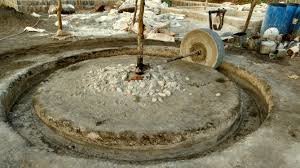Civil Engineering
Partial Addition of Lime in Mortar
Koustubh Prem

Lime has been used as binding materials since ages because it offers greater durability and less strength while being compared with cement. Hydrated lime is soft, flexible and has the ability to move without cracks. Natural Admixtures are used to increase the strength of lime at an earlier time and this reduces the emission of carbon dioxide on the environment produced by the cement.
Read more..
Lime Cement mortar is also called compo mortar and is prepared by mixing cement with lime in certain proportions. The hydraulicity and strength changes as the addition of cement vary. Gauging is used for the addition of cement. Addition of cement makes the lime mortar economical, strong and dense. Generally, hydrated lime or semi hydrated lime or Non- hydraulic lime is used.
Project Description:
Addition of lime to cement is kept partial for enhancing the strength by using a different dosage of natural admixtures and the main aim is to reduce the emission of CO2. Natural admixtures varied from 10% to 50%.
- Lime: Lime is produced by heating limestone which is more or less pure calcium carbonate. During heating, carbon-dioxide is driven off and non-volatile impurities such as oxides of silicon, magnesium, aluminum, iron, and manganese are left behind in the lime.
- Cement:Hydraulic cement, more commonly known as cement, is one of the most basic binding material in almost all civil engineering constructions. The term cement is restricted to the bonding materials used with stones, sand, bricks, building blocks etc., which are used in constructions. The compounds of lime are the principal constituents of this type of cement so that in building in civil engineering we are considered with the calcareous cement. The cement is used in making of concrete which has the property of setting and also used in underwater by good qualities of a chemical reaction with it.
- Jaggery:Jaggery water was used as a natural admixture at the ancient constructions for its good binding properties. Jaggery water is gathered from the palm tree and it has dark brown color. It makes the structure thermally insulated. It has a complex structure combined with sucrose, invert sugar, moisture, and other insoluble matter, like wood ash, proteins, and fibers.
Latest projects on Civil Engineering
Want to develop practical skills on Civil Engineering? Checkout our latest projects and start learning for free
- Kadukkai: It has extraordinary binding and hardened properties. Kadukkai can be used in construction only after it is made into a dried powder form for its effective usage. The dried kadukkai powder is mixed with sufficient water and enclosed for three days for making kadukkai paste. This paste is used for the mortar preparation.
Project Implementation:
- Mixing Proportions:For this experiment take 1:3 proportion and is the rich mortar ratio. Jaggery and Kadukkai.
- Mixture: Natural admixture like jaggery, water and kadukkai paste mixed with water. 50% of the cement was replaced by the hydrated lime powder and mixed with fine aggregates and water.
- Casting: Fresh mortars should be cast into 70.6mm cube moulds for compression testing and must be removed after 48 hours.
- Curing: Specimens are removed from the mould and kept in water for 7-28 days.
- Repeat the above steps forproportion from 10-50% of lime-cement mortar.
 Did you know
Did you know
Skyfi Labs helps students learn practical skills by building real-world projects.
You can enrol with friends and receive kits at your doorstep
You can learn from experts, build working projects, showcase skills to the world and grab the best jobs.
Get started today!
Kit required to develop Partial Addition of Lime in Mortar:
Technologies you will learn by working on Partial Addition of Lime in Mortar:
Partial Addition of Lime in Mortar
Skyfi Labs
•
Published:
2018-10-31 •
Last Updated:
2021-07-02
 Looking to build projects on Civil Engineering?:
Looking to build projects on Civil Engineering?:
 Did you know
Did you know